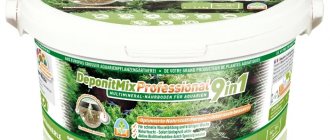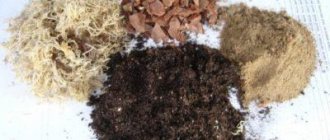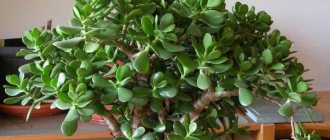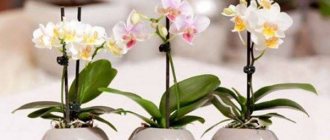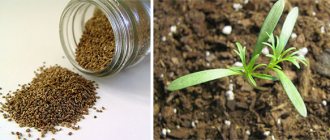For many centuries, European flower growers have been haunted by this question. Therefore, a topic that can easily lift the spirits of a group of orchid lovers is choosing the right substrate for orchids.
This is an important and responsible choice, since planting in an unsuitable substrate can result in the death of the plant.
Is it possible to plant an orchid in plain soil?
To begin with, it is worth knowing that the Orchid family has more than 35,000 species. Among them there are a wide variety of specimens that are able to adapt to any environmental conditions, including soil.
The Orchid family can be divided into several classes according to their mode of existence:
- epiphytes;
- lithophytes;
- terrestrial orchids.
Epiphytes are plants that grow in tropical and subtropical conditions. They prefer to settle on other plants, without parasitizing at their expense. They can be found in the crown of trees, hollows, and forks. Developing in such conditions, these types of orchids receive more light and nutrients than growing below on the soil on their own. They get their food from humus, which is located on tree trunks, and absorb moisture after rain.
Lithophytes are well adapted to life in rocky areas, where mosses and lichens provide good soil for them. At the initial stage of development of these plants, they have enough nutrition, but then they take useful substances from their own dead cells and the remains of mosses and fungi.
Terrestrial orchids grow in temperate climates and inhabit mid-latitudes. But among them there are also many tropical types of crops. Some of them grow well in rocky areas, which makes them look like lithophytes.
When choosing a substrate in a flower shop, you need to pay attention to the composition and structure of the soil in the bag. It shouldn't be a single lump. When planting, you should check whether the substrate contains mold, dust, or foreign inclusions.
Thus, you can plant orchids in plain soil if it contains the mycelium necessary for the plant, with which you can enter into symbiosis.
What problems should you be wary of?
We would be lying if we said that growing an orchid without soil is all about its advantages. Forewarned is forearmed, we believe, so below we list the problems that a gardener should be prepared for.
- The roots are dying. But don't worry: the fact is that the old roots are accustomed to a humid environment. It will not be easy for them to adapt, so some of them will not pass this test. But with proper care, new young roots will definitely appear on the plant, for which the current conditions will be the only ones familiar. And the epiphyte will definitely recover.
- Leaves lose turgor. Turgor is the normal state of a phalaenopsis leaf when it is smooth, glossy, dense and strong. When the leaf blade becomes limp and wrinkled, changes color from green to yellow, they say: “The leaves are losing turgor.” But this problem is as temporary as the death of the roots, so don’t panic.
And finally, a few words about which orchids are suitable for alternative cultivation. First of all, this is phalaenopsis (any of its varieties), as well as dendrobium. However, some varieties of cattleya, as well as other orchids, may also be suitable for growing in expanded clay, bark or sphagnum: it all depends on the capabilities and desires of the grower.
Why are many types of orchids contraindicated in ordinary soil?
In those days, when the orchid was a new thing for many gardeners, and no one knew about the conditions of its maintenance, the flower was planted in ordinary soil for indoor plants. It is not surprising that the exotic plant soon died. Perhaps from that moment on they began to believe that the orchid was very capricious. Then flower growers realized that the crop does not tolerate dense soil. The orchid's root system is designed in such a way that it constantly needs air access.
Deprived of this in ordinary soil, under the pressure of stagnant water, the orchid becomes easy prey for microorganisms that affect the roots of the plant. The process of decay begins in the tissues and, having lost the roots, the orchid dies.
Coconut fiber
Coconut fiber is collected from the inside of coconut shells. This material is highly durable and has excellent breathability. The fiber can be used when growing orchids in baskets to prevent the base substrate from spilling out or for wrapping.
They have money and power: types of men prone to cheating in relationships
We bake a whole basket of “mushrooms”: we take a plastic bottle to help
A fantastic garden in Singapore, a bridge in Vietnam and other new wonders of the world
Do I need to add soil to the soil?
Many people know that planting an orchid in ordinary soil means soon losing the plant, but the question arises whether it is possible to add soil to the soil. Based on what species the orchid belongs to, you need to select the appropriate substrate. However, if the plant is not adapted to ordinary soil, then it is better not to risk the health of the flower.
If the owner knows what variety his orchid belongs to and is confident that it can grow in ordinary soil, then you can prepare a similar mixture yourself.
The classic substrate for orchids should consist of tree bark, with the culture preferring coniferous or a mixture of oak and beech. This composition copes with the delivery of moisture, air and firmly secures the plant in the pot. Moss is necessary to maintain the required level of moisture. In addition, it has bactericidal properties that a tropical plant needs. However, it must be changed at least once a year. Also, the amount of moss is reduced in winter. Charcoal is needed by plants as a sorbent, but it is added to the mixture in limited quantities - no more than 10% of the total mass.
Preparing the mixture yourself requires maintaining the correct proportions. For each variety, the ratio is selected individually.
What kind of land is needed?
Orchids grown at home are divided into two types:
- ground;
- epiphytic.
They differ not only visually, but also in their growing environment. Therefore, the soil for these two species is different.
- For epiphytic plants, soil is not only a source of moisture and nutrition, but also a support. The soil must contain a sufficient amount of mineral and organic substances. For example, you can use 1 part charcoal and 5 parts bark. The following are suitable additional components:
- dry fern roots;
- drainage;
- natural leavening agents.
- Since terrestrial orchid species require intensive nutrition, the following soil is suitable for them:
- peat;
- pine bark;
- leaf humus;
- moss;
- crushed coal.
To improve the soil composition, if necessary, add cork material in the form of plates, turf soil and sphagnum moss.
Preparation of growing substrate
Usually the following components are used to suit the orchid. You need a soil base of leaves, turf, coniferous soil or peat, as well as elements that will add looseness, for example, polystyrene foam, moss, tree bark. Don't forget about organic fertilizers.
When using a substrate prepared independently, you should understand that the correct level of acidity is required, without which it will be difficult for the orchid to develop. Another very important point concerns microorganisms that can live in prepared soil. All components from flower shops have been heat-treated and properly disinfected, this reduces the risk of developing diseases and insects.
Step-by-step instruction
Cover the surface on which you plan to manipulate the transplant with oilcloth or newspaper. This will make it easier to clean up trash after finishing the job. Holding the orchid by the base with one hand, turn the pot upside down and try to gently shake out the plant. Sometimes it happens that the roots grow into holes in the pot or stick to its walls. Under no circumstances pull the plant with force when removing it from the container if this is prevented by overgrown, clinging roots. They are quite fragile and break easily. A less traumatic way out in such a situation would be to carefully trim the stuck shoots with sharp scissors. The instruments that have to be used in the process must be sterilized with alcohol. When transplanting an adult healthy flower, not a complete, but a partial replacement of the substrate is allowed. A sudden change in the chemical composition can have a bad effect on the condition of the plant.
The root system must be carefully examined and its condition assessed
Having taken out the plant, lower it into a basin with a weak disinfecting solution (potassium permanganate or phytosporin). For weakened specimens, it makes sense to add biological products that strengthen the immune system. Carefully straighten the roots, carefully inspect them, cleaning them from the remnants of the old substrate. If you find broken, rotten, dried areas, carefully cut them back to healthy tissue. Sprinkle cut areas or damaged root tips with an antiseptic (crushed charcoal, cinnamon powder). If you suspect the presence of pests, spray the plant itself, the substrate and the container with fungicidal and insecticidal agents. Let the plant dry.
While filling the pot with substrate, the plant must be carefully held in it until the work is completed.
Now that the preparatory stage is completed, we proceed directly to planting. Please note that plastic containers tend to be unstable and the substrate is quite lightweight. It happens that a peduncle with numerous inflorescences, stretching out, can tilt and turn the pot over. A fall can also occur if you move awkwardly. To prevent such situations, it is recommended to pour a little gravel or crushed stone into the bottom of the pot.
A solid block of damp (pre-soaked) bark is placed in a container, a plant is placed on it, the roots must be positioned freely. If some of the roots do not fit, do not try to push them inside; let them remain outside the pot as is. The voids between the roots are filled with medium and fine fraction substrate, distributing and pushing the pieces with a thin stick, without compacting or tamping.
It happens that a small plant with poorly developed roots does not hold well in a pot, falls over and falls out. You can secure it with soft tapes. They fix the orchid by wrapping it crosswise around the “neck” and around the pot. The tapes are removed after the plant has caught on its own roots and acquired a stable position.
Low-growing orchids look good in reliable and practical ceramic containers
To make the pot look more attractive, the roots sticking out of it can be covered with moss and tied with twine, without pressing or pulling too much. But remember that aerial roots actively participate in photosynthesis, almost on a par with leaves, and it is not advisable to completely hide them under moss.
We also invite lovers of home floriculture to learn about the peculiarities of growing Chinese and Japanese roses, which are described in detail in the articles on our website.

